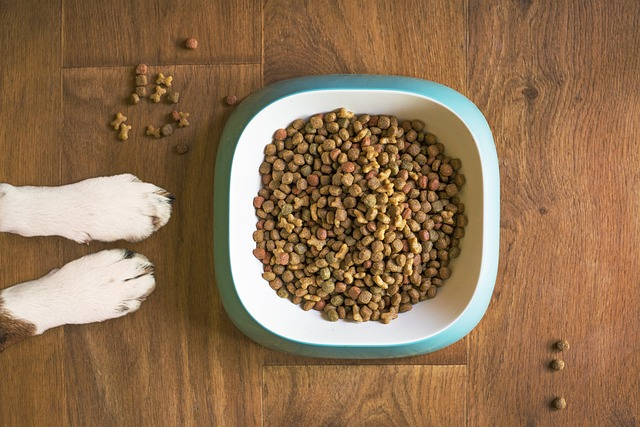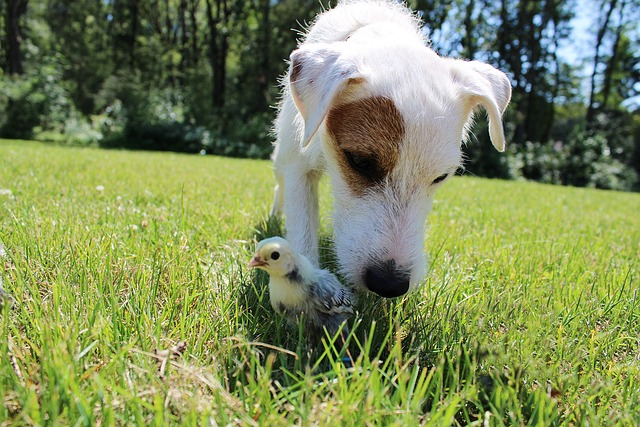Dog Too Much Protein Symptoms – How Much is Too Much?

Key Point:
- Strive for a balanced protein intake tailored to your dog’s age, size, and activity level to avoid potential health issues.
- Watch for signs of excess protein, such as digestive problems, weight gain, or behavioral changes, and promptly address any concerns.
- Regularly consult your veterinarian to ensure your dog’s diet meets their individual nutritional needs and to address any health-related questions.
- When introducing new proteins, take a gradual approach, monitor for allergies, and seek professional advice for a smooth dietary transition.
- Prioritize your dog’s overall health and happiness by making informed decisions about their diet, considering both protein content and other essential nutrients.
As devoted pet parents, we strive to provide our furry companions with the best nutrition to ensure their well-being and longevity.
Protein, a crucial component of a dog’s diet, plays a pivotal role in maintaining their overall health. However, like any good thing, too much of it can have unintended consequences.
In our pursuit of offering optimal nutrition, it’s essential to strike a balance and be mindful of the protein intake in our canine friends.
This blog post aims to shed light on the potential pitfalls of excessive protein consumption in dogs, exploring the symptoms that may arise when their protein levels surpass the recommended thresholds.
Understanding these signs is crucial for responsible pet ownership, allowing us to make informed decisions about our dogs’ diets and promote their long-term health and happiness.
How much protein does my dog need?
According to the PetMd, determining the right amount of protein for your dog is a key element in ensuring their overall health and well-being.
Protein is an essential nutrient that plays a crucial role in building and repairing tissues, supporting immune function, and maintaining a healthy coat and skin.
However, the optimal protein requirement for a dog can vary based on factors such as age, size, breed, activity level, and overall health.
Factors Influencing Protein Needs:
1. Life Stage:
Puppies: Growing puppies have higher protein requirements to support their rapid development. Look for puppy-specific formulas that provide the necessary amino acids for optimal growth.
Adult Dogs: Adult dogs generally have lower protein needs compared to puppies. However, active breeds or working dogs may require a higher protein content to sustain their energy levels.
2. Size and Breed:
Larger breeds may have different nutritional needs than smaller breeds.
Large and giant breeds, for instance, may benefit from diets that support joint health, which can include specific protein levels and sources.
3. Activity Level:
Highly active dogs, such as those involved in agility or working roles, may require more protein to fuel their increased energy expenditure.
On the other hand, less active or senior dogs may need a diet with a lower protein content.
4. Health Considerations:
Dogs with certain health conditions, such as kidney issues, may require a specialized diet with controlled protein levels.
It’s crucial to consult with your veterinarian if your dog has specific health concerns.

How to Determine the Right Amount:
1. Check the Dog Food Label:
Pet food labels provide information on the percentage of protein in the product. Look for a well-balanced formula that meets your dog’s specific needs.
2. Consult with Your Veterinarian:
Your veterinarian is an invaluable resource when it comes to tailoring your dog’s diet.
They can assess your dog’s overall health and provide personalized recommendations based on factors like age, weight, and activity level.
3. Monitor Your Dog’s Condition:
Pay attention to your dog’s body condition, energy levels, and coat quality.
If your dog is maintaining a healthy weight, has good energy, and sports a shiny coat, you’re likely providing an appropriate amount of protein.
4. Adjust as Needed:
Dogs are individuals, and their nutritional needs may change over time.
Regularly assess and, if necessary, adjust their diet to accommodate any changes in activity level, age, or health status.
Balancing the right amount of protein in your dog’s diet is a key aspect of responsible pet ownership.
By understanding your dog’s unique requirements and making informed decisions, you contribute to their overall health and happiness.
Dog Too Much Protein Symptoms
Ensuring your dog’s protein intake is balanced is vital for their health. Watch out for these signs of excessive protein:
- Digestive Issues: Diarrhea, vomiting, or flatulence.
- Increased Thirst and Urination: Signs of potential kidney strain.
- Weight Gain: Especially if it exceeds energy expenditure.
- Skin and Coat Problems: Dry skin, excessive shedding, or hot spots.
- Behavioral Changes: Hyperactivity, restlessness, or increased anxiety.
- Kidney Strain: Lethargy, decreased appetite, and changes in urination.
- Joint Problems (Large Breeds): Stiffness, lameness, or difficulty in movement.
Consult your vet if you notice these symptoms. Adjusting your dog’s diet can ensure they enjoy a healthier and happier life.

Factors that affect your dog’s protein needs
Understanding the factors that influence your dog’s protein needs is essential for providing them with a balanced and nutritionally sound diet.
Here are key factors to consider:
1. Age:
Puppies: Growing puppies have higher protein requirements to support their rapid development. Look for specially formulated puppy diets that provide the necessary nutrients for growth.
Adult Dogs: As dogs reach maturity, their protein needs may decrease. However, this can vary based on factors like breed and activity level.
2. Size and Breed:
Larger breeds may have different nutritional needs than smaller breeds. Large and giant breeds, in particular, may benefit from diets that support joint health and may require specific protein levels and sources.
3. Activity Level:
Highly active dogs, such as those participating in agility or working roles, may require more protein to sustain their energy levels and support muscle development.
Less active or senior dogs may not need as much protein, and feeding them a diet appropriate for their lower activity level is crucial to prevent excess calorie intake.
4. Health Status:
Dogs with certain health conditions, such as kidney issues or allergies, may require specialized diets with controlled protein levels.
Consult with your veterinarian to determine the best approach for your dog’s specific health needs.
5. Reproductive Status:
Pregnant or nursing dogs have increased protein requirements to support the growth and development of the puppies.
Specialized diets for breeding dogs are available to meet these unique nutritional needs.
6. Individual Variations:
Just like humans, each dog is unique. Some dogs may thrive on diets with higher protein content, while others may require a more moderate approach.
Monitor your dog’s condition, and adjust their diet as needed.
7. Overall Diet Composition:
The balance of macronutrients in your dog’s diet matters. It’s not just about the amount of protein but also the proportion of fats and carbohydrates.
A well-rounded diet contributes to their overall health.

Meeting your dog’s protein needs involves a nuanced understanding of various factors.
By considering their age, size, breed, activity level, health status, reproductive condition, and individual variations, you can tailor their diet to promote optimal health and well-being.
Regular consultations with your veterinarian play a crucial role in determining the most suitable protein intake for your furry friend based on these factors.
Will Too Much Protein In A Dog’s Diet Cause Health Problems?
While protein is an essential component of a dog’s diet, providing numerous benefits for their overall health, it’s crucial to strike a balance.
Too much of a good thing can potentially lead to health problems in our canine companions.
Let’s delve into the potential issues associated with excessive protein intake in a dog’s diet.
1. Digestive Issues:
Consuming an excess of protein can strain a dog’s digestive system. This may manifest as symptoms like diarrhea, vomiting, or gastrointestinal discomfort.
Sudden dietary changes, including a significant increase in protein, can disrupt the delicate balance of the digestive tract.
2. Weight Gain:
Protein-rich diets, especially those with more calories than a dog expends through activity, can contribute to weight gain.
Obesity in dogs is associated with a host of health issues, including joint problems, diabetes, and a decreased lifespan.
Monitoring calorie intake alongside protein content is crucial to maintaining a healthy weight.
3. Kidney Strain:
One of the most significant concerns regarding excessive protein intake is its potential impact on kidney health.
While there is debate on the exact relationship between protein and kidney function, it’s generally agreed that dogs with pre-existing kidney issues may need a controlled protein diet.
Consultation with a veterinarian is essential to tailor the diet to the individual dog’s needs.

4. Calcium Imbalance:
High-protein diets can sometimes lead to an imbalance in calcium levels, which is critical for bone health. This is particularly relevant in large and giant breeds prone to skeletal issues.
Ensuring a well-rounded diet that considers not just protein but also other essential nutrients is crucial.
5. Allergies and Sensitivities:
Some dogs may be sensitive or allergic to certain protein sources. Introducing too many protein-rich ingredients, especially novel proteins, may increase the risk of allergies or food intolerances.
It’s important to monitor your dog for signs of allergic reactions, including itching, ear infections, or gastrointestinal upset.
6. Behavioral Changes:
In some cases, an excess of protein might contribute to hyperactivity or changes in behavior. While this isn’t a direct health problem, it can impact the quality of life for both the dog and their owner.
While protein is a vital element of a balanced canine diet, moderation is key.
It’s essential to tailor your dog’s nutrition to their specific needs, considering factors such as age, size, activity level, and overall health.
Regular consultations with a veterinarian, monitoring your dog’s well-being, and being mindful of the ingredients in their food are proactive steps in promoting a healthy and happy life for your furry friend.
Striking the right balance ensures that your dog receives the nutrients they need without compromising their well-being.
How to introduce a new protein to your dog’s diet
- Gradual Transition: Mix the new protein gradually with their current food over a few days.
- Monitor for Reactions: Watch for signs of allergies or sensitivities. If observed, consult your vet and discontinue the new protein.
- Choose Quality Sources: Opt for lean, high-quality proteins like venison, rabbit, duck, or fish, tailored to your dog’s needs.
- Check Nutritional Balance: Ensure the new protein is part of a well-balanced diet. Confirm with your vet for personalized advice.
- Rotate Proteins: Provide variety by rotating different protein sources to prevent sensitivities.
- Maintain Portion Control: Avoid overfeeding; adjust portions based on your dog’s weight and needs.
- Consult Your Veterinarian: Before significant dietary changes, seek guidance from your vet for a tailored approach.
Enjoy exploring new flavors with your pup in a way that supports their health and keeps mealtime exciting!

Can protein sources cause allergies in dogs?
Yes, protein sources can be a potential trigger for allergies in dogs.
While proteins are essential nutrients, certain sources may provoke an immune response in some dogs, leading to allergic reactions.
Common protein allergens for dogs include beef, chicken, dairy, and eggs.
Signs of protein allergies in dogs may include itching, skin inflammation, gastrointestinal upset, and, in severe cases, respiratory issues.
If you suspect your dog has a protein allergy, consult with your veterinarian to determine the specific allergen and develop an appropriate dietary plan.

FAQs
1. Can dogs be allergic to certain proteins?
Yes, dogs can develop allergies or sensitivities to specific proteins. Common signs include itching, gastrointestinal upset, or changes in behavior.
If you suspect an allergy, consult your veterinarian for guidance.
2. Can high-protein diets improve a dog’s coat condition?
Yes, high-protein diets are often associated with improved coat health. Proteins are essential for skin and coat development, promoting a shinier and healthier appearance.
However, balance is key, and consulting with your vet is advised.
3. Can dogs have too much protein?
According to the American Kennel Club, Yes, excessive protein intake can lead to health issues such as digestive upset, weight gain, or kidney strain. It’s important to provide an appropriate amount of protein based on your dog’s age, size, and activity level.
4. Can dogs with sensitive stomachs tolerate high-protein diets?
According to the VCA hospital, It depends on the individual dog. While some dogs with sensitive stomachs may tolerate high-protein diets well, others might experience digestive issues.
Gradual introduction and monitoring are essential. Consult your vet for personalized advice.
5. What are High-protein dog foods?
High-protein dog foods contain elevated levels of protein, often sourced from meat, fish, or other animal products.
These diets are designed to meet the nutritional needs of active dogs or those with specific health goals.
Always choose high-quality, balanced options suitable for your dog’s requirements.

Final Notes
In conclusion, recognizing and meeting your dog’s protein needs is a dynamic and individualized process.
The careful consideration of factors such as age, size, activity level, health status, and overall diet composition allows you to tailor your nutrition effectively.
Striking the right balance in protein intake promotes optimal growth, energy levels, and overall well-being.
Regular consultations with your veterinarian are key to ensuring that your dog’s dietary requirements are met, addressing any specific health concerns, and fostering a happy and healthy life for your canine companion.
As a responsible pet owner, staying attuned to your dog’s evolving needs and making informed decisions about their diet are pivotal steps in promoting a long and vibrant partnership with your furry friend.
